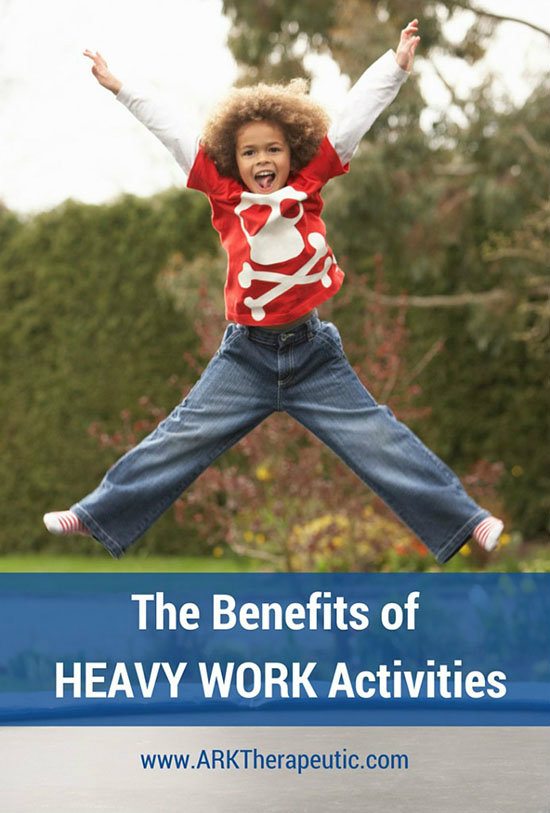Sensory Benefits of Heavy Work Activities
14th Dec 2015
Heavy work activities are any type of action that pushes or pulls against the body. This could be tension created by something pushing/pulling against your body (like swimming where the water pushes against the body) or tension that the body itself creates (like monkey bars where the body’s own weight creates the resistance).
.

.
Who can benefit from heavy work activities?
Everyone! Everyone needs heavy work activities to some extent. After all, it’s mostly exercise and getting the body moving, which all of us need. However, heavy work is of particular benefit for individuals with sensory processing issues for several reasons, such as:
.
1. It provides proprioceptive input to the muscles & joints. This can be very calming, organizing, and regulating, decreasing stress and anxiety.
2. Children with sensory processing issues often don’t know where they are in time and space. It’s why they might move a lot or swing or crash into things - they’re trying to get grounded. Heavy work can help give them that grounding and increase body awareness.
3. It can help decrease the need to chew. Many individuals with sensory processing needs tend to chew as a way to self-regulate. It is a very simple yet effective calming strategy, and there are many chew tools available specifically to meet this need. However, some individuals have a very overwhelming, aggressive, and destructive need to chew that can affect their quality of life. Oftentimes chewing is the most extreme when there isn’t a sensory diet / other calming mechanisms in place, so they default to chewing instead. When the whole body is getting the right amount of proprioceptive input (through heavy work for instance) throughout the day, the need to chew typically decreases.
4. Heavy work / proprioceptive input can increase focus and attention. With the right sensory input, children are able to sit still longer because they feel grounded and know where they are. For instance, one of my therapy kiddos is very impulsive. So at the beginning of each session I let him go on the jungle gym for a couple minutes first to regulate his system. Afterwards he can sit down and better focus, and I don’t spend as much time redirecting him during therapy.
5. Heavy work activities have a residual effect. Think about your arms feel after you’ve carried something heavy for a while - even after you’ve let go, your arms still feel the weight, and you’re more aware of your arms and muscles. For this reason, if a person gets the right amount of proprioceptive input throughout the day, it can help prevent sensory overload altogether and keep them focused and calm.
.

.
What some heavy work strategies might look like:
• Swimming is great because the water is always pushing against your body no matter how you move
• Wheelbarrow walking (walking forward on your hands while someone else holds your feet) • Crab walking
• Army crawling
• Doing chores (yes chores!) - sweeping, mopping, vacuuming, pushing a laundry basket around, etc.
• Carrying something heavy - have them carry a pail of water across the backyard, (unbreakable) grocery bags into the house, etc.
• Swinging (if they are actively pulling and pumping their body)
• Kneading, pulling, squeezing, and playing with putty / play dough
• Jumping on a trampoline
• Jumping rope
• Pushing/pulling oneself on a scooter board
• Climbing a jungle gym
• Playing tug of war
• Chewing
.
So as you can see, a lot of different activities count as heavy work and provide input to the muscles and joints. Most of them are also fun, so kids won't even know that they are doing something therapeutic for their sensory systems.
.
Tips to keep in mind: .
• Like most things in life, each person’s need for heavy work will vary. Some kids need really heavy, input, while others require less intense input. And this may vary from day to day.
• Heavy work activities is about finding right amount of input for each person. For example, if they are carrying something that is too lightweight, it's not going to provide any benefit. Or if it’s too heavy, it may be frustrating. This is where an occupational therapist (OT) will come in to assess the child’s individual needs and find a ‘happy medium’ of appropriate activities.
• Sometimes kids don’t see the point in doing these activities or in going from point A to point B. So give them a functional task to do. For example, you can say: “Can you take these to the kitchen for me?” to have them carry something with weight. Or if you’re at the jungle gym, put toy turtles or sharks at the end of the monkey bars as an endpoint /goal.
• Don’t make these activities a punishment (“you tackled your brother, now go do 10 crab walks”). It’s not their fault that they don’t know how to properly regulate their needs. So make it a game instead, and have everybody participate.
• Although it’s rare, occasionally heavy work activities may increase one’s the activity level instead of having a calming effect. It’s not for everyone, so watch the child’s reactions closely and of course, consult with your OT.
• Most importantly, have fun with these heavy work activities for sensory seekers:)
.

